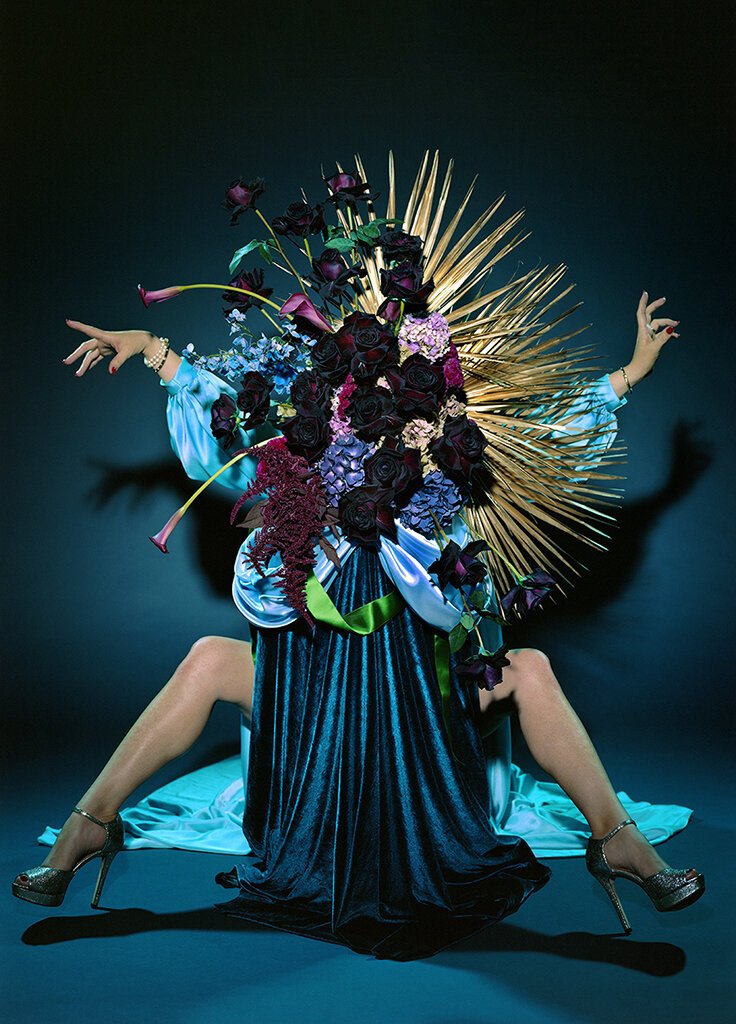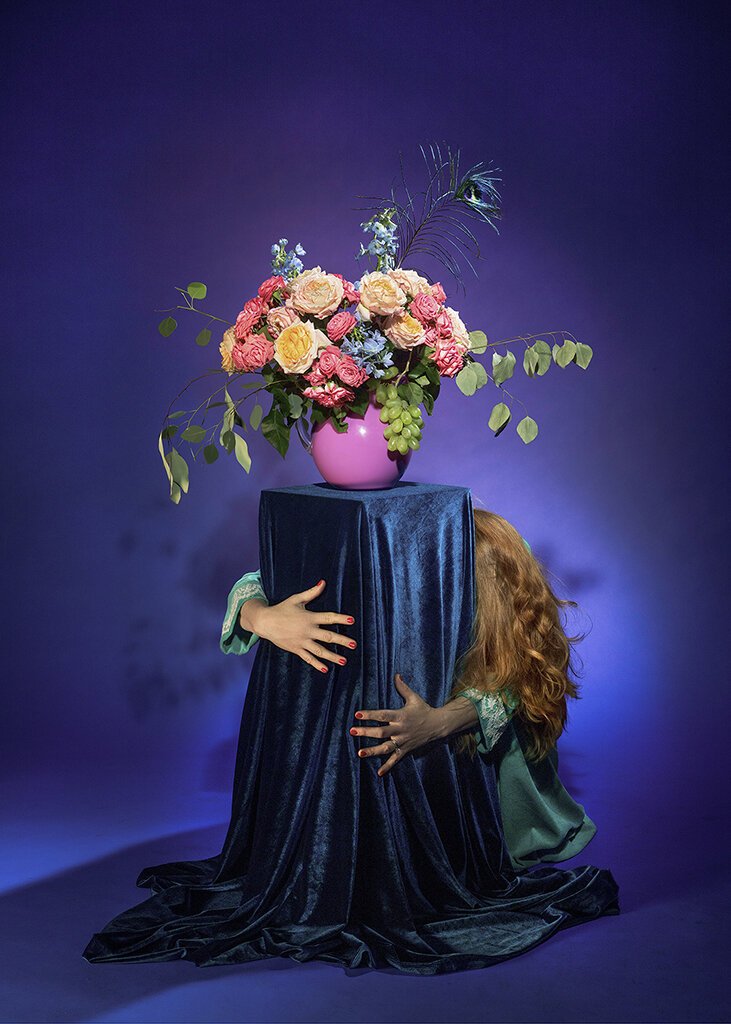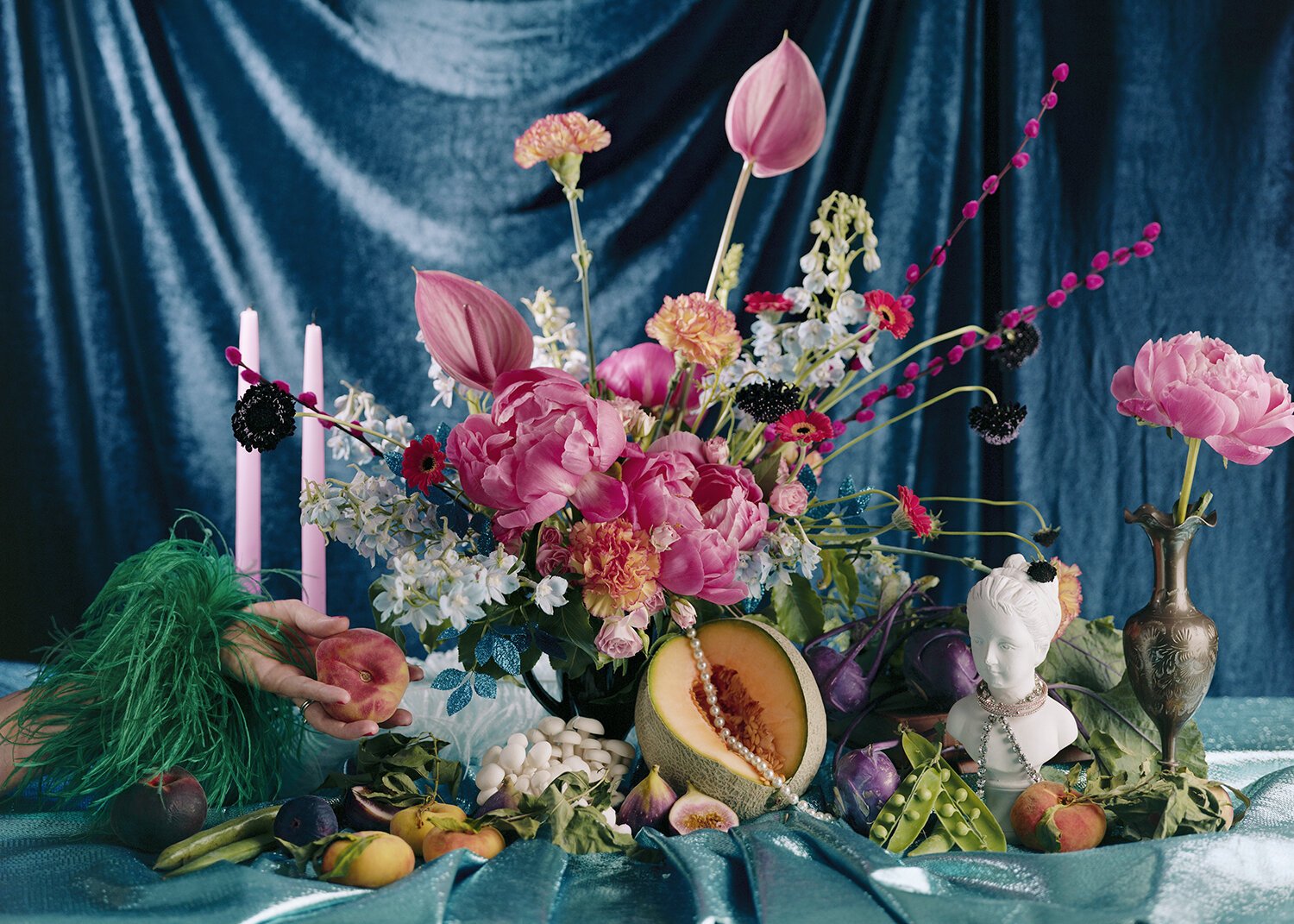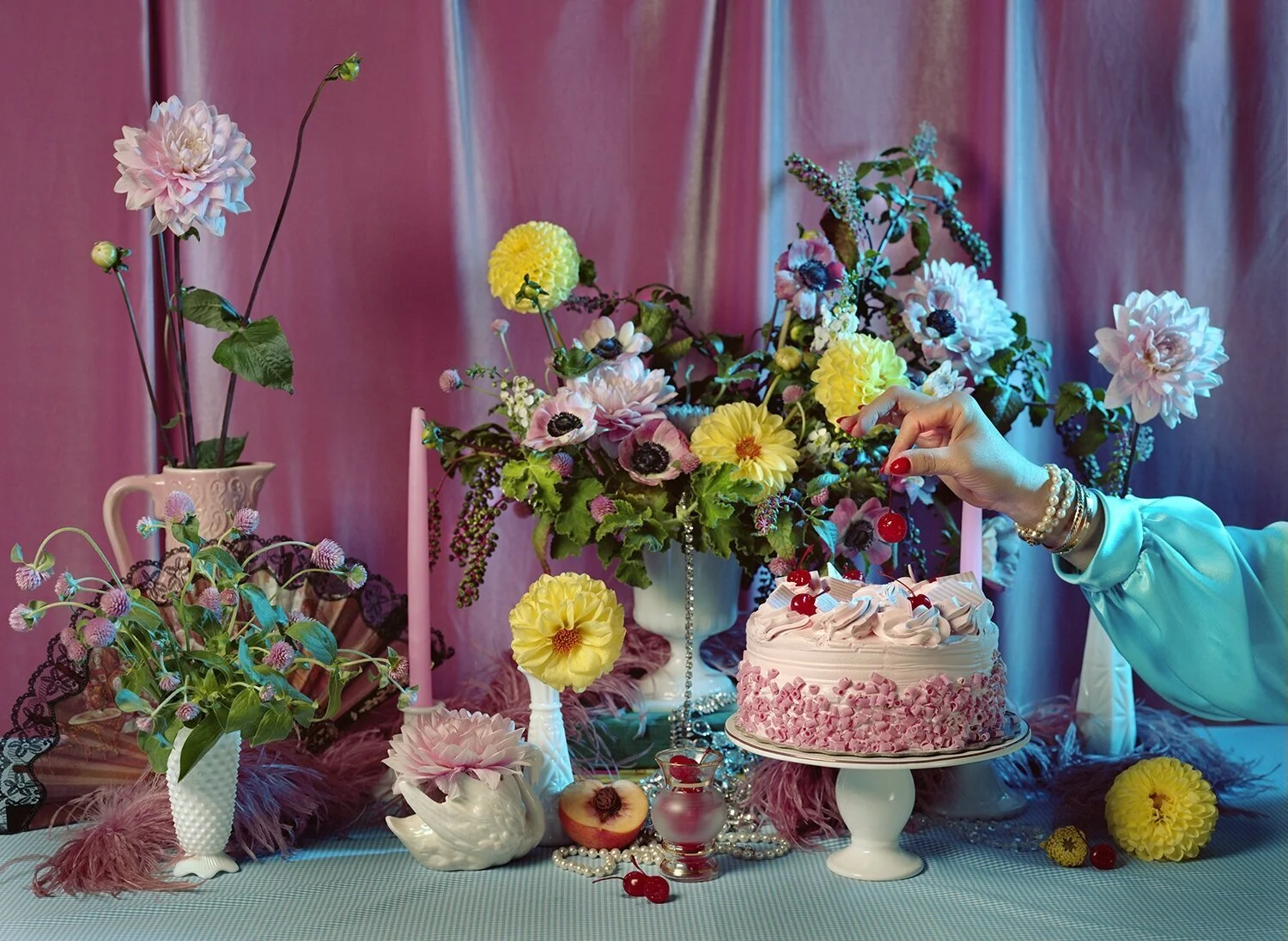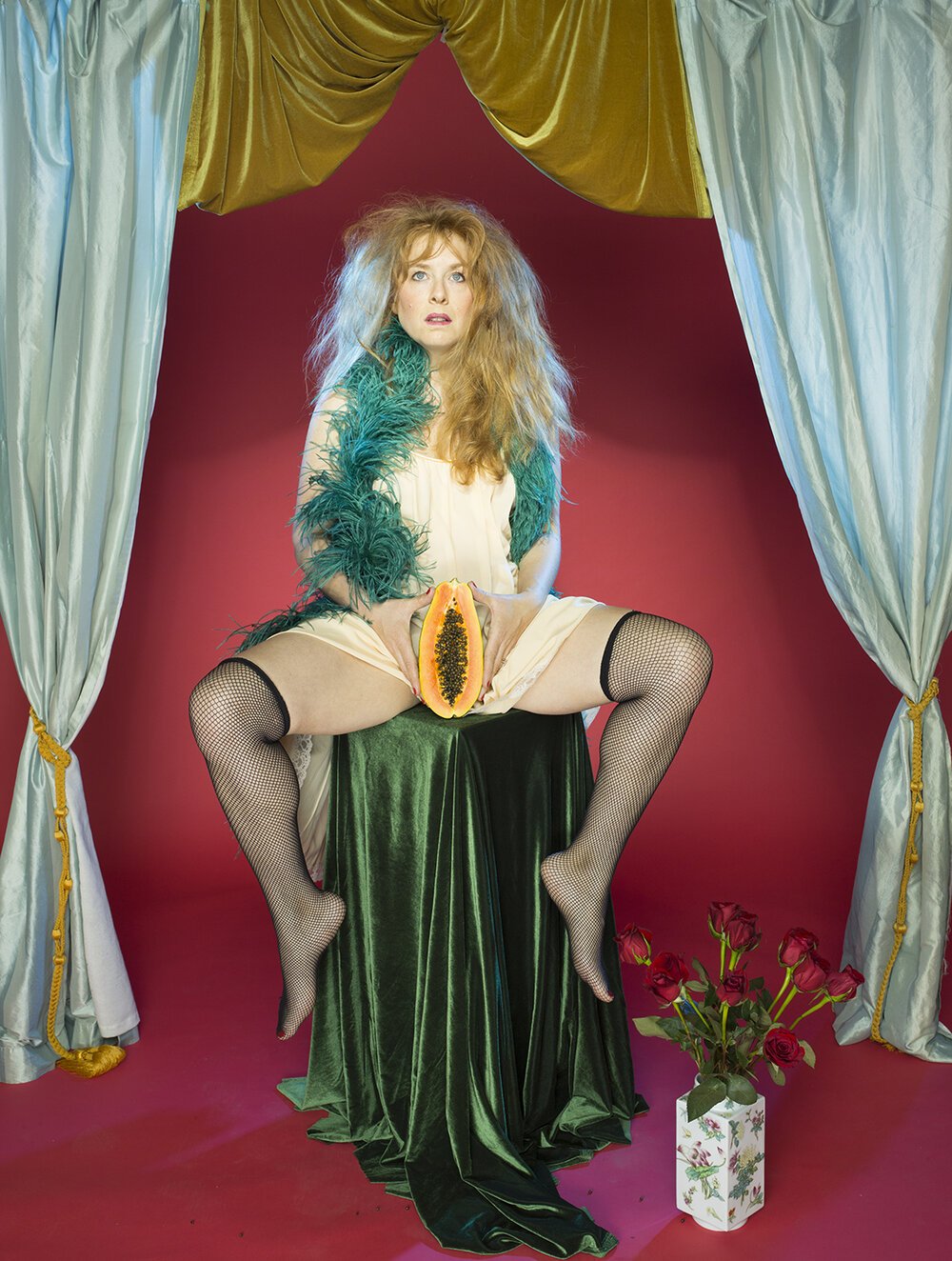Amanda Rowan: Seductive Rituals
November 7th, 2020
Working at the intersection between performance and photography, artist Amanda Rowan has created her own visual world of richly styled vignettes. Utilising a mixture of visual iconography, including still life, food advertising, vintage pinups, and religious deities; her unmistakably feminine pieces use a mixture of humour and seduction to explore the strengths and vulnerabilities of sexuality. Beautiful and mystical, her work tells timeless stories of domesticity through surrealist burlesque.
We caught up with Amanda to talk more about influence, colour and symbolism, along with the importance of having fun whilst working.
POL: Hi Amanda, first up, can you tell us a little about yourself and how you would define your work?
AR: I am a multimedia artist, a photographer/director, performer, and educator. My art practice involves building elaborate sets out of inherited objects and organic matter to explore ideas around mysticism, seduction, domestic labor, and gender. I use photography and video to shoot still life and self-portrait stories in the spaces I create.
POL: Your background is really interesting - starting out photographing rock concerts during high-school and coming from an artistic household - what was it that drew you initially to photography?
AR: I have been privileged in that both my parents are artists who prioritised self-expression. My Father Peter Rowan is a singer-songwriter and taught me to value the process of researching. He spends months traveling, reading, and learning about a time in history or music genre while writing an album. My Mother is a fashion stylist and art collector. She taught me to see the beauty in little details. I have always been drawn to photography. At first, it was a way for me to interact with the performers I met when I was growing up. But then it became part of my self-expression.
POL: There is a clear theatrical element in your work, and we know you were an actor in your 20’s alongside being involved in performance art now, does the performative nature of your art inform how you take photographs?
AR: In my 20’s it was easy to define my craft as “ACTING” but now I see that performance has always been a part of my practice as an artist. The performative nature of my work manifests itself in both building a sculpture like a cake for example and then photographing it and destroying it. The performance of creation and documentation are intertwined.
“I have always been drawn to photography. At first, it was a way for me to interact with the performers I met when I was growing up. But then it became part of my self-expression.”
POL: There are clear elements of burlesque in your work, and it’s really interesting to see, even in still life works, a sense of eroticism. Do you think a sense of sensuality and seduction is an important part of photography?
AR: I have always been drawn to burlesque performance and pin-up art. There is an element of Camp and playfulness in which the women are aware of objectifying themselves that is both innocent and knowing. I think this mix of humour and seduction both disarms and engages the viewer in a deeper conversation about the subjugation of female sexuality.
POL: Your images can confidently be described as feminine, do you think of your use of gendered iconography (that of flowers and fruit for example) as a political statement?
AR: I use beautiful and familiar elements to seduce the viewer into engaging with the work on a political level. The sexuality, humour, and beauty in the images open up a dialogue about my experience navigating power and vulnerability as a woman.
POL: We love your series Ritual and would love to know more about it. What was the inspiration behind the project?
AR: The process of making Ritual was a wonderful surprise. I originally went into the studio to experiment shooting large format and explore still life as a way to take a mental break from shooting portraits. I have a few simple storyboards I had made and a ton of objects I had been collecting. But after the first day when I looked at the images, I knew there was something deeper being expressed. I began to investigate the images and almost decode them for myself to see what I was making and trying to say. It was an incredible lesson to see how one can subconsciously use symbols to express a deeper meaning. Once I started to understand what I was looking at I started to create for a more direct place.
“I use beautiful and familiar elements to seduce the viewer into engaging with the work on a political level. The sexuality, humour, and beauty in the images open up a dialogue about my experience navigating power and vulnerability as a woman.”
POL: Would you say your work is self-portraiture? What draws you to inserting parts of yourself into your imagery?
AR: I believe all photography is a self-portraiture on some level. But yes, many of my images are quite literally images of parts of myself. I love shooting other people yet there is an element of collaboration that is inherently voyeuristic. Removing that from my work sometimes makes it more straightforward. When I step into the frame it feels like the purest expression of what I am trying to say.
“I love this idea of objects being a secret language. It feels like a subversive way to fight operation through an aesthetic depiction of beautiful “things.” ”
POL: We’d love to know more about some of your influences. Looking at your still life work, for example, you can see a visual relationship between it and 17th century Dutch still life paintings. What drew you to this style of work? Are there any other aesthetic influences you’re able to pinpoint?
AR: I think the tradition of Dutch still-life painting is extremely interesting. On one level it was a sign of status to document all your beautiful things and show the world your collections and bounty. We do this today in our Social Media posting of food and other objects. But the Dutch were being religiously oppressed and in order to express their beliefs, they would use shared symbolic meaning in the objects that they painted to communicate with the viewer and each other. I love this idea of objects being a secret language. It feels like a subversive way to fight operation through an aesthetic depiction of beautiful “things.”
POL: Across all of your work you are unafraid of bold color choices, can you tell us a little bit about your use of color?
AR: I am never afraid things will “clash” or be too vivid. I am interested in the semiotics of color and what color communicates to the viewer. It's another tool of visual language.
POL: What’s interesting about your work is that your visual language is so well defined. For example, your work communicates with a sense of humour and fun. How do you bring this into your work? Do you think it is something missing from popular photography?
AR: That's probably because I am having fun! Lol, I am always after the challenge of how I can tell a story in one single image. Humour is probably my favourite way to do this. We usually see it in advertising, but it's tricky to do well I think.
POL: Like many art photographers your practice also includes a commercial arm that translates your visual style into imagery for advertising and campaigns. For you, do you notice your commercial and personal projects informing each other?
AR: They do. I think the more I shoot personal work the better my commercial work becomes and vice versa.
POL: You shoot a lot of film photography, is there something about analog photography you particularly enjoy? Do you have a go-to medium or format?
AR: I think film has an energy to it that is powerful. It slows me down. The process becomes step by step. Each shot is important. I like the ritualistic pace of film. My favourite is shooting Large format 4x5 color film.
POL: You’re part of the faculty at Photo Arts Conservatory in the New York Film Academy Los Angeles, so you see and interact with so many young photographers each year. If you were to give one piece of advice to someone starting out in the industry what would it be?
AR: I consider myself extremely lucky to be an educator. Helping to inspire and foster other artists is truly a joy. I feel grateful for my students as I often learn just as much from them.
To emerging artists, I would say two things: One) value the research; read, go to museums, look obsessively on Pinterest, and in international photo magazines. Try your best to define what lights you up visually! And Two) stop making work you think you should make and make exactly what you want, even if it seems silly or frivolous. Make the work that lights you up.
POL: If money and time were no object, what would your dream project be?
AR: My dream is to direct long-form art films and feature films, and also more music videos.
“Stop making work you think you should make and make exactly what you want, even if it seems silly or frivolous. Make the work that lights you up.”
POL: What are you working on now? What’s next for you?
AR: I have been quarantined in Hawaii for the last few months and I created a new body of work I am calling “White Pineapple.” It is a project that mixes still life and landscapes exploring privilege and colonialism on the “Garden Island.”
About Amanda Rowan
Amanda Rowan's provocative still life and self-portrait images depict playful and sensual moments, eliciting humour through an exploration of the power and vulnerability of sexuality. Rowan is both curator and subject in each richly styled vignette depicting moments of mysticism and seduction. Her work explores domestic labor and gender using a mix of visual iconography, including food advertising, vintage pinup, and religious deities.
Rowan has received numerous accolades for her art, including "The Curator Award 2019", by Photo District News (P.D.N.), "Photographer of the Year 2018" by the International Chromatic Photography Publication and the Tokyo International Award for Photography in 2019. Her work has been exhibited internationally at the Carrie Able Gallery, Photo LA, Art Basel, The Wall Street Gallery, The Leica Gallery in Los Angeles. Her images hang in the permanent collection at The Palms Hotel in Las Vegas with Damien Hirst, Jean-Michel Basquiat, Andy Warhol, and Takashi Murakami.
Rowan graduated Cum Laude from Tisch School of the Arts at NYU. After a successful tenure in New York City shooting celebrities, she now lives in Los Angeles, working within the genres of photography and performance art. Rowan is currently a Full-Time Faculty at the Photo Arts Conservatory at the New York Film Academy Los Angeles in both the MFA and BFA programs.

